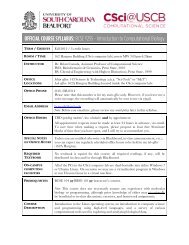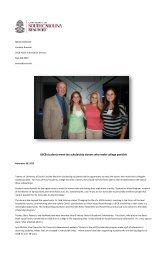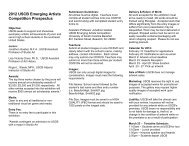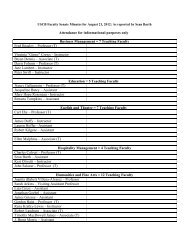2012-2013 Unaccompanied Homeless Youth Verification Form
2012-2013 Unaccompanied Homeless Youth Verification Form
2012-2013 Unaccompanied Homeless Youth Verification Form
Create successful ePaper yourself
Turn your PDF publications into a flip-book with our unique Google optimized e-Paper software.
<strong>Unaccompanied</strong> <strong>Homeless</strong> <strong>Youth</strong> <strong>Verification</strong>USC Beaufort Financial Aid/VA Office801 Carteret Street Beaufort, SC 29902Office: (843) 521-3104 Fax: (843) 521-3194Name of Student: _________________________________________________________________________DOB: ________________ Telephone Number_____________________ SSN: XXX-XX-_________Current Mailing Address of Student: ________________________________________________________City: _____________________________ State: _________ Zip_____________I am providing this letter of verification as a (check one):_____ A McKinney-Vento School District Liaison: ____________________________________________________ A director or designee of a HUD-funded shelter: _________________________________________________ A director or designee of a RHYA-funded shelter: ________________________________________________ A financial aid administrator: ____________________________________________________________As per the College Cost Reduction and Access Act (Public Law 110-84), I am authorized to verify thisstudent’s living situation. No further verification by the Financial Aid Administrator is necessary. Shouldyou have additional questions or need more information about this student, please contact me at thenumber listed above.This letter is to confirm that ______________________________________________was:Please Check One:_____ An unaccompanied homeless youth at any time on or after July 1, <strong>2012</strong>.On or after July 1, <strong>2012</strong>, _____________________________ was living in a homeless situation, asdefined by Section 725 of the McKinney-Vento Act, and was not in the physical custody of a parent orguardian._____ An unaccompanied, self-supporting youth at risk of homelessness at any time on or after July 1, <strong>2012</strong>On or after July 1, <strong>2012</strong>, _______________________________ was not in the physical custody of aparent or guardian, he/she provided for his/her own living expenses, and is at risk of losing his/herhousing.Authorized Signature:Print Name:Date:Telephone:Title:Agency:
MORE INFORMATION ABOUT UNACCOMPANIED HOMELESS YOUTHWho are <strong>Unaccompanied</strong> <strong>Homeless</strong> <strong>Youth</strong>? <strong>Unaccompanied</strong> homeless youth are young peoplewho lack safe, stable housing and who are not in the care of a parent or guardian. They may have runaway from home or been forced to leave by their parents. <strong>Unaccompanied</strong> youth live in a variety oftemporary situations, including shelters, the homes of friends or relatives, cars, campgrounds, publicparks, abandoned buildings, motels, and bus or train stations.Between 1.6 and 1.7 million youth run away from their homes each year. i Generally, youth leavehome due to severe dysfunction in their families, including circumstances that put their safety andwell-being at risk. Unfortunately, physical and sexual abuse in the home is common; studies ofunaccompanied youth have found that 20 to 50% were sexually abused in their homes, while 40 to60% were physically abused. ii <strong>Unaccompanied</strong> youth do not receive financial support from theirparents and do not have access to parental information.Who are McKinney-Vento School District Liaisons? Under subtitle VII-B of theMcKinney-Vento <strong>Homeless</strong> Assistance Act, every school district is required to designate a liaisonfor students experiencing homelessness. <strong>Homeless</strong> liaisons have a number of legal responsibilitiesunder the Act, including identifying youth who meet the definition of homeless and areunaccompanied. The education subtitle of the McKinney-Vento Act is overseen by the U.S.Department of Education. For more information, see:http://www.ed.gov/programs/homeless/legislation.htmlWhat are HUD-funded Shelters? The U.S. Department of Housing and Urban Development(HUD) administers funding for homeless shelters and services under Title IV of the McKinney-Vento Act. These funds are distributed to communities through a competitive grant process. <strong>Form</strong>ore information, see: http://www.hud.gov/offices/cpd/homeless/programs/index.cfmWhat are RHYA-funded Shelters? The U.S. Department of Health and Human Servicesadministers the Runaway and <strong>Homeless</strong> <strong>Youth</strong> Act programs. These programs provide funding forBasic Centers, Transitional Living Programs, and Street Outreach Programs that serve runaway andother unaccompanied homeless youth. For more information, see:http://www.acf.hhs.gov/programs/fysb/content/youthdivision/index.htm#sub1i Hammer, H., Finkelhor, D., & Sedlak, A. (2002). “Runaway / Thrownaway Children: National Estimates andCharacteristics.” National Incidence Studies of Missing, Abducted, Runaway, and Thrownaway Children. Washington DC:Office of Juvenile Justice and Delinquency Prevention. See also Greene, J. (1995). “<strong>Youth</strong> with Runaway, Throwaway, and<strong>Homeless</strong> Experiences: Prevalence, Drug Use, and Other At-Risk Behaviors.” Research Triangle Institute. Washington DC:U.S. Dept. of Health and Human Services; National Runaway Switchboard, http://www.1800runaway.org/.ii Robertson, M. & Toro, P. (1999). “<strong>Homeless</strong> <strong>Youth</strong>: Research, Intervention, and Policy.” Practical Lessons: The 1998National Symposium on <strong>Homeless</strong>ness Research. Washington DC: U.S. Dept. of Housing and Urban Development. RetrievedJuly 18, 2007 from http://aspe.os.dhhs.gov/progsys/homeless/symposium/3-<strong>Youth</strong>.htm. See also MacLean, M.G., Embry,L.E. & Cauce, A.M. (1999). “<strong>Homeless</strong> Adolescents’ Paths to Separation from Family: Comparison of FamilyCharacteristics, Psychological Adjustment, and Victimization.” Journal of Community Psychology, 27(2), 179-187.










